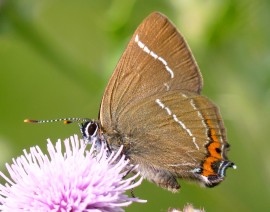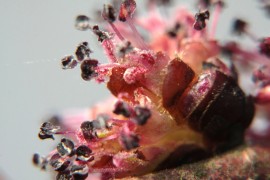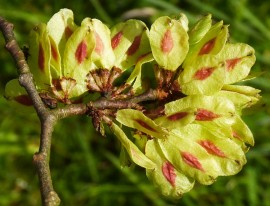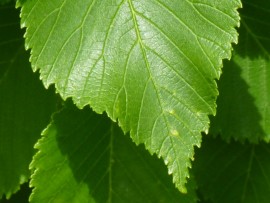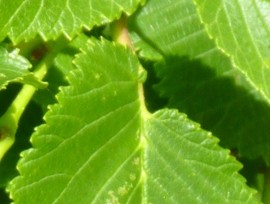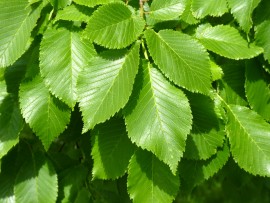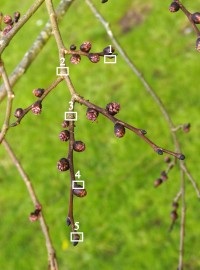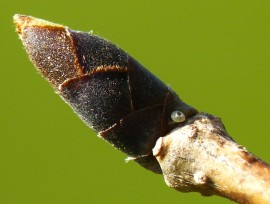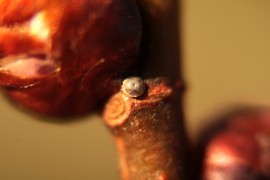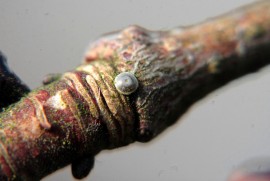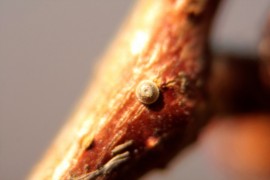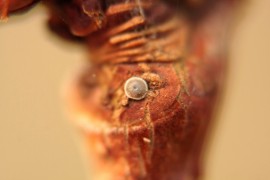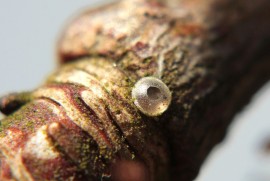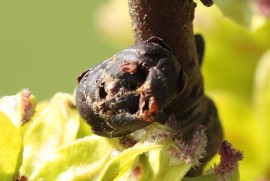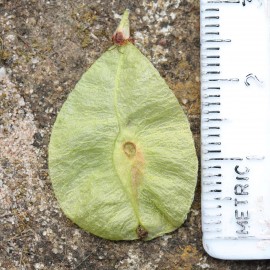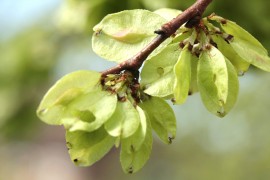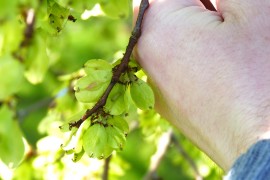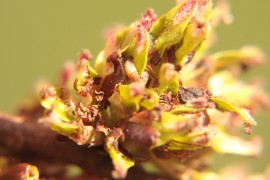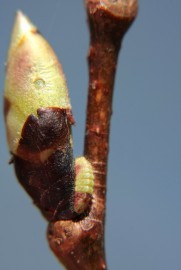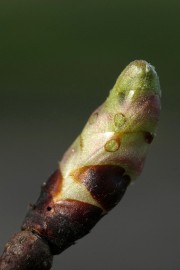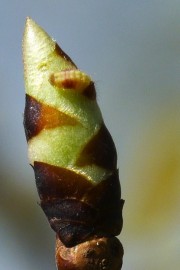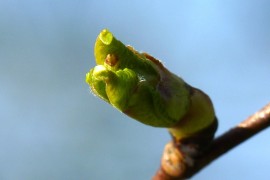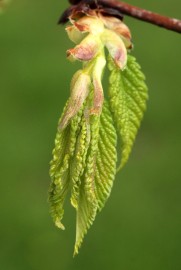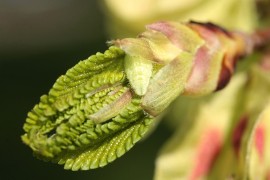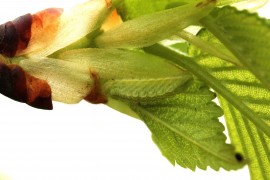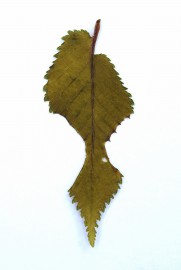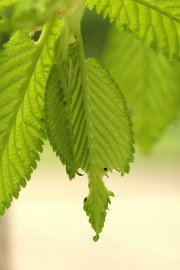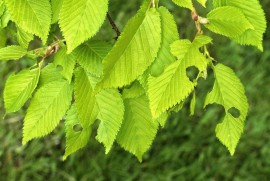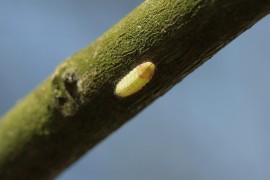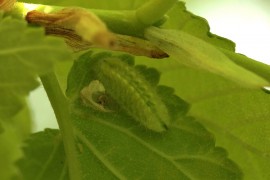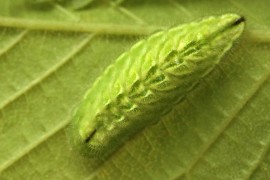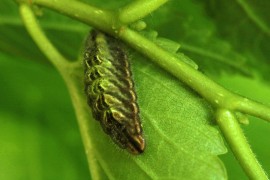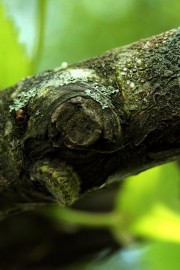White-letter Hairstreak
by Jamie Burston
This captivating species has an arboreal lifestyle and is therefore somewhat elusive, as a result it is greatly under-recorded. As a result it's been hard to properly assess the distribution of the butterfly and the toll taken by Dutch Elm Disease.
The devastating effects of Dutch Elm Disease (DED) has caused widespread habitat loss within the UK, to control the spread of infection many Elm trees continue to be cut down, removing the White-letter Hairstreaks only foodplant from most of the landscape. Within the centre of Sussex, Brighton and Hove remains to be an exception, with fast acting management to destroy infected trees and stop the spread. Find out more about the story and effects of Dutch Elm Disease in it's own section below.
Part One: Elm (Ulmus)
How do you find White-letter Hairstreak colonies? White-letter Hairstreak is a species solely reliant on Elm (Ulmus) trees as a foodplant to complete its life cycle. A number of individuals will reside on a single tree consisting of both male and female White-letter Hairstreaks to form a colony. Locating and identify Elm will give you the opportunity to search for White-letter Hairstreaks. Elm occurs in variety of habitats from roadsides, parks, cemeteries, private gardens, allotments, countryside field margins and downland.
Below are illustrated photos showing the most widely occurring features which distinguish Elm from other tree species. I have include the full Elm life cycle, this of which is deeply intertwined with that of the White-letter Hairstreaks life cycle. Being able to identify Elm buds, flowers, seeds and leaves as they develop in that order will allow you to identify Elm trees throughout the year whatever the season. I haven't included the months of which flowers, seeds and leaves develop as different Elm varieties vary in the timing and speed of which they pass through the life cycle. Look for any of the following features to aid in identification -
Flower buds (refer to Figure.6): Predominantly more rounded, expressing a red hue and a fuller shape grow on the sides of twigs, the direction of growth is at an angle to that of the direction of the twig. Huntingdon Elm has particularly large, rounded and glossy flowers buds, one of Brighton and Hove's most abundant elm varieties. Please note that only mature elm is capable of producing flowers and seeds, those of younger trees will proceed to go straight into leaf.
Leaf buds Like flower buds they are found towards the tip of twigs, expressing a darker, typically more brown hue in colour. Leaf buds point in the same direction as the individual twigs, leaf buds have pointed tips and can vary in length down to the variety of elm you find. Up close, unopened leaf buds will show a lattice of protective scales that eventually peel apart as the leaves inside develop - (See photo ''5'' in Egg section below).
Elm flowers: Once the flowers buds burst your find the anthers breaking through, saturated in a rich and deep pink colour, supported by white, pink or green filaments which make up the stamen. As the flowers develop the anthers will open and turn dark brown (pictured) revealing the white pollen grains. As the flower matures they will gain an overall green appearance, produced when the stigmas and style develop to collect the pollen. Now the seeds will begin to develop. To understand flower anatomy, visit here: https://www.amnh.org/learn/biodiversity_counts/ident_help/Parts_Plants/parts_of_flower.htm
Elm seeds: Seed are contained within wings of tissue, a structure described as a Samara, the seed is contain within a central capsule, typically but not always adorned with a pink hue. Samaras will vary in colour, either from a green colouration to a pale yellow hue (like that of Wheatley Elm, another abundant elm within Brighton and Hove). At the peak of seed development, from a distance you can easily mistake the tree being covered in young leaves. After some time the samaras will turn brown in colouration. Elm generally finds it hard to self-propagate with success.
Elm leaves: The key feature which identifies elm is the occurrence of asymmetrical leaf lobes (Fig 4), one side larger than the other but the ratio between each side can vary between different varieties, always located at the base of the leaf where joining the leaf stem. Another feature of elm leaves is a toothed edge, whilst all elm varieties will have a tapered leaf tip (Fig 5), the length and pronunciation can vary greatly. The most likely species to get elm confused with is hazel, use the earlier indicators of flowers and seeds to separate the two species.
Part Two: Egg /Ovum
Female White-letter Hairstreaks lay the majority of eggs during mid-July, this behaviour may occur into early August. When first laid the eggs appear green in colouration but later the shiny and somewhat transparent surface of the eggs turns a subtle blue tint of grey. The eggs have a beautiful structure, complete with added white fringing, in a certain light the surface of eggs will shimmer, showing tints of pink and blue. Without seeing an egg laying female the best time to search for eggs is in the Winter (December to March) when the leaves are out of the way.
My searches of eggs (I've now found around 20 White-letter Hairstreak eggs as of 2016 - 18 Feb 2017) has helped to highlight the portion of tree that is would appear females prefer to lay their eggs on. All the eggs I've found fall within the West - South - East portion of a compass, with my finding currently showing an emphasis on the South facing portion of Elm trees. The following link can help as a tool to determine where best to search for eggs on potential trees you find -http://googlecompass.com/
Important note: Based on my observation this year (2017) of Huntingdon Elm it would suggest that the season is a week ahead of last year with earlier flower bud development. I would therefore say that it's worth looking for inhabited eggs until the 3rd week of March 2017, after which I would imagine the majority of caterpillars will have emerged.
Based on first-hand experience of trying to find my very first White-letter Hairstreak egg I would suggest taking a few helpful tools along with you on your search, a hand-lens or a camera with a macro lens/setting to aid in identification. Depending on your eye sight at close range once you have seen a few eggs you should be able to correctly identify what you're looking at without any aid. Another key tool to help in your search is to understand the size of a White-letter Hairstreak egg, like other Hairstreak species the egg is very small in size, 1mm in diameter to be precise! Take a small ruler with you while searching, one of the biggest problems I first had was overestimating the size of the egg, always imagining it to be much larger, if this gets into your head your start to overlook small structure like the eggs on the Elm tree.
Important note of care: Please always be aware of where your placing your hand on branches and twigs when grabbing to steady your view, always look first where you place your hands on the tree as you never know where the eggs could be! Below should help but caution should always be used to avoid damage. Never attempt to search for eggs during windy periods or days, it poses the risk of harming eggs and the tree!
The labelled numbers shown on (Figure.6) refer to the following photos below and the various position you may find White-letter Hairstreak eggs. Please note although only one example ''box'' is given for each position, eggs will be laid on the multiple available positions.
1: Eggs may be laid on the ''plateau'' formed to the side and base of both flower and leaf buds and the base of each twig.
2: Eggs may be laid on the twig itself, where there is a fork with another twig.
3: Eggs are most obvious to spot when laid on the ''scar band'' on twigs, created where old hard wood of the previous year meets new green shoots which hold the leaves during the summer of the current year. In winter the green twigs harden and change colour to a dark red/brown hue. As the best time to search for eggs is in winter when the leaves have gone these red/brown twigs will be what you see. The scar band is highlighted where these dark red/brown twigs which have this year's flowers, meets old, slightly lighter brown coloured twigs (see Figure.6)
4: Eggs may be laid at the base of unopened flower buds, a great advantage as the caterpillar to emerge will burrow straight into the flower buds to feed.
5: Eggs may be laid on or at the base of the unopened leaf buds, these leaf buds will later burst and the shoots will contain the years leaves and the following springs flowers buds.
Tip: Based on the number of positions female White-letter Hairstreaks may lay her eggs, to give yourself the best chance of find them it's advised to search all twigs at every feature (1-5) when looking.
During your searches you may find hatched eggs from the previous year, clearly so if found before January. If hatched eggs are found later it might suggest that this years caterpillar has emerged. Empty hatched eggs are capable of staying on the tree up to a year after the caterpillar has emerged.
Sadly with any species which overwinters in the egg stage there is the risk of disease. Below is a photo of a diseased egg (on the right) compared to the healthy appearance it had before (on the left). Disease likely set in due to poor weather conditions.

Fig 8 Healthy (left) and diseased (right) White-letter Hairstreak egg
Please let us know if you find any White-letter Hairstreak eggs within Sussex, we would like to hear from you!
Part Three: Caterpillar / Larva
Caterpillars will typically emerge from the egg during the last few weeks in February and throughout March. Observing the emergence of the caterpillars is somewhat difficult based on my observations (2017), the approach to emergence is given away when a small hole is made in the centre of the egg (Micropyle), through which you might be able to make out the caterpillars dark shiny head. It's hard to judge when caterpillars will emerge, although caterpillars have made exit holes in the top of eggs, they will hold on until darkness to make their escape to the nearest flower buds, which there then burrow into for protection and to feed. Although I haven't seen a caterpillar emerge from the egg they would be around 1mm in length, around the size of the egg they came from.
I haven't been able to locate caterpillars whilst they feed upon the buds and the following open flowers, not seeing them for an average of 30 days before I can spot my first caterpillar from their emergence. It isn't a good idea anyway to search the flowers as they are delicately attached to the tree and can easily be knocked off. During flower and seed development you should restrict contact to only holding/steadying the bare branches if needing to acquire a better view, this will avoid knocking the delicate buds off, doing so would cause habitat loss and could endanger the caterpillars, be careful and never handle the tree in windy conditions.
Below (Fig 1) illustrates bored holes in a undeveloped flower bud, possibly created by a White-letter Hairstreak caterpillar:
If you were able to located the current years eggs in the winter, there is still a chance of finding the caterpillars near to the eggs, waiting until the flowers have finished and the seeds begin to develop. Feeding damage on seed should be visible on most elm varieties during April, the best time of the month to search for feeding damage will vary from year to year depending on: the development of the seed, how plentiful they are in a particular year and when the majority of seed begins to shed from the tree.
White-letter Hairstreak caterpillars feeding damage on seed samaras, illustrated below. Note the small size of the caterpillar, 4mm in length in (Fig 2.5) with my hand, used to give a sense of scale, this was taken 5 April 2017:
Note that the characteristic holes in the seed are focused in the centre of the samaras, with entry holes made in the central seed compartment, the central seed compartment can either be pink (see Egg section - Fig 2) or remain the same colour as the paper like tissue surrounding it (see Fig 4, above).
At this point you may wish to use a hand lens or a camera with a macro setup to closely inspect the seeds and leaf buds to confirm the presence of telltale feeding damage marks.
In mature trees the flowers and seeds will develop before the leaf buds being to expand. Whilst in younger trees, flowers and seeds won't be produced and will soley develop leaves, going to leaf much sooner than mature trees.
The leaf buds typically begin to develop towards the end of seed development.
The same type of feeding damage seen on the seeds should also be seen on the expanding leaf buds when the bud scales peel apart revealing green/yellow and pink tissue (see Fig 5 with caterpillar below). Like the seeds the leaf bud feeding damage consists of small circular holes, browning at the edge (see Fig 5.5 below), the caterpillars burrow and anchor their head into the buds which they feed upon, which in turn creates these holes.
During 2016 I first found caterpillars on the very tips of expanding leaf buds (see Fig 6 below) matching their colouration to the buds they rest on, however this year (2017) seed production has been far more plentiful and longer lasting on Huntingdon elm. Because of the extra shelter and protection the seeds provide the caterpillars have rightly chosen to stay within the seed clusters for longer, even when leaves are expanding. During 2016 a caterpillar made full use of the shelter provided by a newly opening leaf bud (see Fig 7 below).
When the leaf buds fully open the young tender leaves will be on show (see Fig 7.5 below), depending on the amount of seed still around the caterpillars will typically rest within the leaf bud scales (see Fig 8 below), at this stage feeding damage on the leaves themselves might not be apparent. The maturing caterpillars continue to reply on the leaf bud scales to hide within or mimic, as a form of camouflage (see Fig 8.5 below), located where the leaves meet the stem.
Moving into May feeding damage on the developed leaves should become apparent and more noticeable. If you were not able to locate eggs earlier in winter, now is the best opportunity to search as their presence will be given away. Come mid-May the weight of the tree being in full leaf will bring the branches closer to you, in 2016 all of the caterpillars I had found within reaching distance were in the first 2 meter of the tree (measured from the ground). Huntingdon elm as a variety does have low hanging branches, so for other Elm varieties with higher out of reach branches, binoculars will become a useful tool.
The most distinctive and striking feeding pattern created by the White-letter Hairstreak caterpillars that I've observed on Huntingdon elm is illustrate in (Fig 9, 10 & 11 below):
The feeding damage leaves a characteristic diamond shape at the tip of the leaf. Once the leaves are the only thing on the tree it becomes easier to find and spot the caterpillars, by looking for fresh feeding damage you should be able to follow their movement on the tree, they must become nocturnal feeders as throughout 2016 I never saw them actively feeding during the day, rather just resting and moving from branch to branch in search of new leaves (see Fig 12 below). From my observations White-letter Hairstreak typically stay within a meter radius of their eggs to feed. When an Elm tree is in leaf, your best off checking the undersides of the leaves without touching the tree first, then if you spot a caterpillar, note it's position, typically the best way to turn over a leaf is by holding the very tip, where caterpillars rarely rest. Again, never touch the tree in windy conditions.
When the leaf bud scales which the caterpillars replied upon for shelter, dry and turn brown in colour (mid-May for Huntingdon elm) the caterpillars use the leaves in an increasing way, caterpillars by this point typically rest on underside of the leaves, positioning themselves around the asymmetrical lobes of the leaves (see Fig 13 below) and may rest on the stem of the leaves, camouflage at this point is their main attempt of protection (see Fig 13.5 below).
Toward the end of May, the caterpillars gear up for pupation changing their colour (see Fig 14 below), in sunlight they appear dark mauve, whilst in shade they look dark brown. At least with my observation on Huntingdon elm, unlike when feeding, they begin to stray further to find a pupation site, travelling along various branch systems to find a cosy recess or crack in the bark to pupate. Below (see Fig 15) the caterpillar here is trying out one of the various places it sampled as a pupation site.
In the instance of White-letter Hairstreak on Huntingdon elm, really the only way you would find the pupation site was if you were present to follow the caterpillar to it's final resting place on a branch. During 2016 it would appear that the caterpillars started to wondered off to pupate from around 20th May, at that time the average size of the caterpillars was 1.5cm in length. It has however been documented that on different varieties of Elm, White-letter Hairstreak caterpillars behave differently around the time of pupation, this is covered in the Chrysalis/Pupa section below. It's clear that the way White-letter Hairstreak caterpillars look and behave is highly variable and dependent on what is available to them at the time and the variety of Elm they use. A large factor which will affect the rate of development of both tree and caterpillar is the weather, this will ultimately govern the emergence date of the adult butterflies.
I hope to see White-letter Hairstreak caterpillar photos taken by our members in Sussex being posted onto our branch sightings page! It would be great to keep everyone who gets involved informed of how the caterpillars/season is developing with one another.
Part Six: How to approach your search to find the presence of White-letter Hairstreaks on Elm - surveying for colonies.
The following information is solely based on my own personal observations.
There are factors which will influence your chances of spotting a White-letter Hairstreak colony in an Elm tree, the information below will hopefully help you step by step. As you combine the information together, you should eventually be able to predict and look exactly where you need to on an Elm to see White-letter Hairstreaks, even before they come into view.
Below I expand on these factors so to give you an idea of where to focus your search and improve your chances of spotting White-letter Hairstreaks on an Elm tree, thus finding new colonies which your local Butterfly Conservation branch would love to hear about!
Flight period - when in the year to search.
In Sussex the White-letter Hairstreaks flight period has more recently begun during the first weeks of June (2017-2018) when the first males emerged - males emerge before the females. I would however start searching in the last two weeks of June as standard and throughout July, which can tail off after the 20th if an early emergence. Another great indicator of when to search is to see if anyone else has reported sightings of the butterfly on your local branch website of Butterfly Conservation. They can still be seen during the first two weeks of August, when experiencing a more typical flight period - with the first sightings in the latter half of June.
Time of day - when in the day to search.
Put simply I would suggest the best (average) time to search, to see activity is between 8am and 12pm (midday). I can see activity which continues into the late afternoon, however after 5pm the numbers seen and the frequency of activity typically tails off. Don't rule out the option of searching between 12pm and 5pm if your day prevents you from searching earlier, many good sightings could still be had. Rarely but on extremely hot evenings, such as during heatwaves, temperatures can persuade for some activity as late as 6pm - 8pm. Numbers seen throughout the day could be reflective of a smaller or larger colony as populations can fluctuate from year to year, as well as other factors described in this wider section.
Position of the sun - dictates where they are more likely to be active and fly.
Over past years I have noticed that White-letter Hairstreaks, especially regarding the males, tend not to fly on the portion of the tree which is directly aligned with sunlight. Instead, White-letter Hairstreaks will fly around the portions of the tree which are on the margins of where sunlight meets the cusp of shade. As illustrated below - Fig (add number). This could be due to the butterflies darker colouration, avoiding the direct strength of the sun's rays to minimise the risk of over-heating. You should therefore always target you search efforts on the two available options of where sun meets the cusp of shade, this greatly narrows down the area of the tree potentially wasted on looking at.
The above rings true especially for the morning and early afternoon. Later in the afternoon or early evening, if the days temperature allows for continued activity you may find that the butterfly is more willing to freely fly across the sunlit portion of the tree, as the suns strength weakens towards the hours nearing sunset or when direct sun is obstructed - such as the case of overcast conditions. The suns location, giving you the two portions of the tree where sun meets the cusp of shade, ties in directly to the weather to give you the exact side of the tree you solely need to focus on, read below.
Weather conditions - dictates where and if your see activity/flying.
The weather will certainly influence your chances of seeing White-letter Hairstreak activity.
Rain - though I have seen White-letter Hairstreaks still fly in fine drizzle, whilst it's raining I would consider it a waste of time.
Sun - covered by the above listed factor.
Cloud - If it's cloudy or overcast, this should not affect your chances of seeing activity, the air temperature does however need to be warm enough for them to initiate flight.
Temperature - Despite not making notes of the lowest and highest temperatures during which White-letter Hairstreaks will fly, 15�C and above can be considered ideal for searching, you typically get a sense of if it's too cool, when stepping outside. Low 20's are perfect up to a border line of 25�C, if the temperature goes much higher you may notice that White-letter Hairstreaks either seek shade amongst the tree as it's too hot or they choose to fly earlier or later in the day, in short burst of activity, so not to burnout.
Wind - besides the position of the sun, wind tends to be the most crucial factor when it comes to weather for the butterfly. White-letter Hairstreaks will tolerate the slightest of breezes, however anything beyond that and they will refuse to fly in the face of it, which makes sense as they would burn up unnecessary energy trying to fly and maneuver against the wind. It therefore makes the most sense to target the side or portion of the tree which is sheltered and facing out of the wind, it's this in combination with the sun's position which gives you the exact area of the tree to target your gaze, illustrated below - Fig (add number).
I had a great example of the wind and sun's correlation in the success rate of seeing the butterfly, earlier in June (2018) I went out not looking at the weather conditions, I found in the morning the wind was coming from the east and so was the general direction of the sun at that time, the conditions suppressed activity, thinking of my prior knowledge I waited until early afternoon as the sunlight continued to swing further around the tree throughout the day, the wind coming from the east now wasn't an issue, the sun was now in the south, producing stable conditions in the south-west facing portion of the tree, where it was both out of the wind and had an area where the sun from the south met shade from the north side of the tree, here I looked and sure enough I saw males flying, proving how sun and wind correspond.
Behaviour of males and females - at what height on the Elm to look.
The behaviour of males and females is different in the way they use and spend their time on the tree.
I divide the Elm in height by three sections, top - canopy, middle and bottom of the tree, as illustrated below - Fig (add number).
Males : Will spend the vast majority of their time in the top section of the tree, the canopy. They use the canopy to establish their individual territories, giving rise to the most noticeable of all activity, males chasing and dog-fighting, initiated when they come into close proximity with one another, illustrated in the footage below. The middle section of the tree is used by males in a different way, here might still produce chasing and dog-fighting behaviour, but they tend to more regularly patrol this area with less disturbance, flying back and forth. Males between chasing and dog-fighting will visit the bottom section of the tree to rest and regain their energy, angling their wings completely flat to absorb as much warmth to engage their flight muscles (Fig).
The flight of chasing and patrolling male White-letter Hairstreaks, in the elm canopy. Illustrated above. (View on a large screen in HD for best results)
The spiraling aerial display of two male White-letter Hairstreaks dog-fighting over territory, ascending upwards into the sky. Illustrated above. (View on a large screen in HD for best results)
Females : Will spend the vast majority of their time between the middle and bottom section of the tree, making them far more elusive as their sight is more rarely seen breaking into uncluttered sky. Any White-letter Hairstreak seen flying slowly around the lower branches of an Elm tree at first can be assumed to be a female, of which is indicative of females carefully searching for places to lay their eggs. Females will, like the males, visit the middle section of the tree, where calmer from male activity above in the canopy. Females will visit the canopy, the top of the tree, when wishing to mate with a male.
White-letter Hairstreaks of both sexes will take advantage of the trees form, the butterfly is particularly fond of flying in gaps formed by the trees undulating growth, acting as sheltered troths or valleys where pockets of warmer and calmer air can sit, see Fig (number) below. The outer most projecting growth which helps to form these valleys on the tree also can create "shelves", where rows of (sunlit) foliage line up forming a flat horizontal plateau, a feature which the butterfly is fond of using, this may potential act as a type of highway to aid their navigation of the tree.
Identifying White-letter Hairstreak on Elm at distance, avoiding false sightings.
The above videos should hopefully help you to identify the characteristics of White-letter Hairstreak flight. There are other insects that are typically encountered flying around Elm trees which should be noted, these are Bees, Flies, and other Butterfly species.
Bees and Flies will either pass by the tree or will hover in a particular area, both of which can be indicators of the calmest part of the canopy from the wind. Both appear oblong in shape and have a more straightforward flight pattern, there is no visible movement of their wings at distance, giving them a static form. Unlike White-letter Hairstreak males which can dart and turn instantly back on themselves, with clear purpose to their change of direction, you can notice even at distance, that their wings move, changing their form as they fly. White-letter Hairstreaks at distance are typically viewed as silhouetted triangles when stationary, at rest. Their size when seen up-close is comparable to that of a two pence piece, at distance this makes them larger than Bees.
The typical view of a White-letter Hairstreak perched at the edge of a leaf, silhouetted by the sun, it's the triangle on the elm tree. Illustrated above. (View on a large screen in HD for best results)
Butterfly species which can be confused with the White-letter Hairstreak during their flight period are the Holly Blue, Purple Hairstreak and Brown Hairstreak based on their similar size, here binoculars are a very helpful tool should they rest, to aid in identification. Holly Blues will typically pass over the face of the tree and continue on its journey elsewhere, with a silvery-blue appearance. The Purple Hairstreak - silver in flight has grey wings when closed and the Brown Hairstreak has orange wings when closed, should you see the butterfly open its wings you can instantly rule them out as being the White-letter Hairstreak, they never open their wings at rest - only during flight. The Meadow Brown, Gatekeeper and Speckled Wood could also cause confusion at distance, as of the colour of their closed wings and the fact that they like to perch in trees and shrubs, however these species are all larger in size and are likely to move off the tree with time, back to lower levels.
Time taken to look at an Elm - can make all the difference.
I consider 15 minutes to be the standard and the minimum time to look at an individual Elm tree. 15 minutes allows time for you to assess the position you need to take to maximise your chances of seeing activity, such as gauging the weather and sun's position. Activity can be infrequent, 15 minutes gives a chance of seeing something, if you see White-letter Hairstreaks within a few minutes or seconds - fantastic, keep looking on the tree until 15 minutes is up or look longer to see if the number of White-letter Hairstreaks you see, increases. If 15 minutes passes by without a sighting, consider holding on longer, moving onto another Elm tree if there is one nearby and you can always come back to it, or try the same tree again another day/week.
Get recording, thank you!



